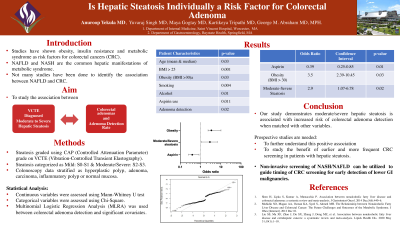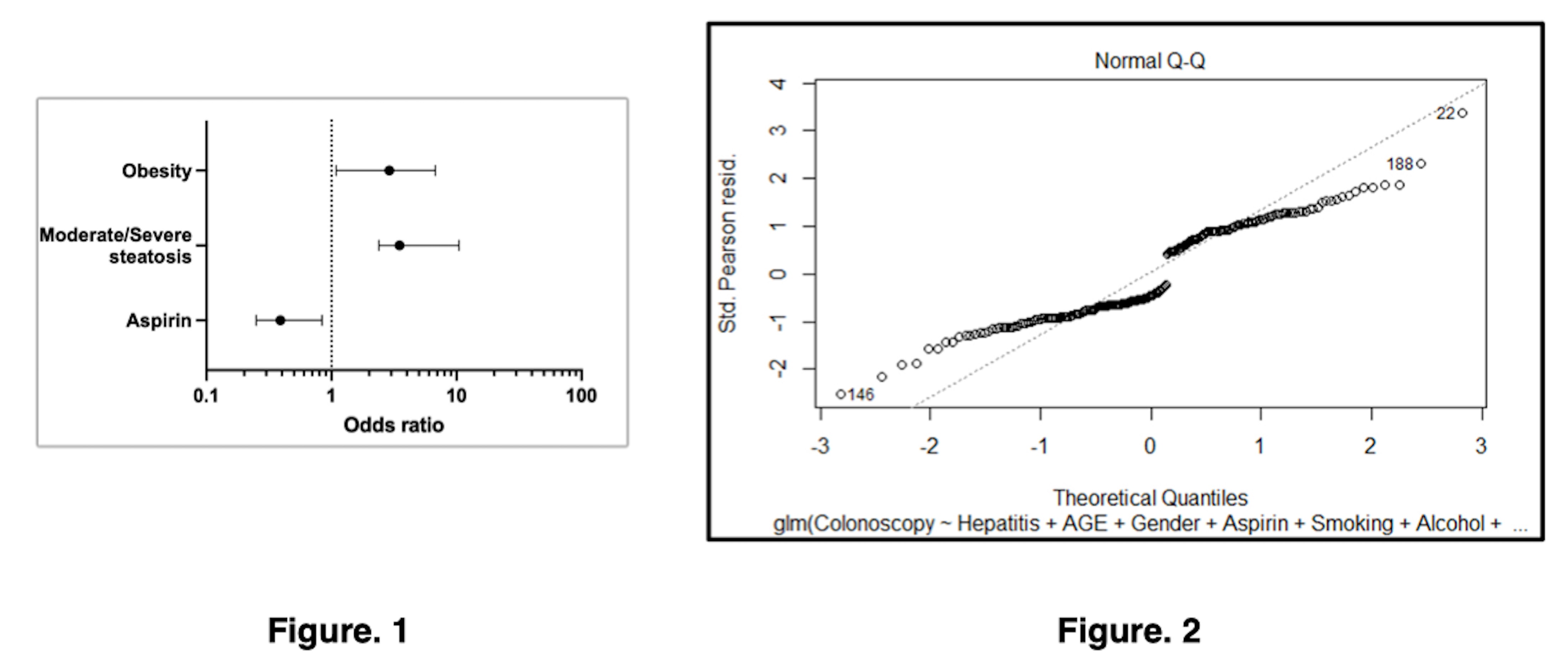Back


Poster Session D - Tuesday Morning
Category: Colorectal Cancer Prevention
D0167 - Is Hepatic Steatosis an Individual Risk Factor for Colorectal Adenomas?
Tuesday, October 25, 2022
10:00 AM – 12:00 PM ET
Location: Crown Ballroom

Has Audio

Anuroop Yekula, MD
Saint Vincent Hospital
Worcester, MA
Presenting Author(s)
Anuroop Yekula, MD, Yuvaraj Singh, MD, Maya Gogtay, MD, George M. Abraham, MD, MPH
Saint Vincent Hospital, Worcester, MA
Introduction: Most colorectal cancers (CRC) originate from adenomatous lesions. Data suggests that obesity, insulin resistance, and metabolic syndrome are risk factors for CRC. Non-alcoholic fatty liver disease (NAFLD) is one of the manifestations of metabolic syndrome. Many studies have correlated metabolic syndrome with a risk of CRC but there is a paucity of evidence on NAFLD and its association with CRC. We aim to study the association between moderate to severe hepatic steatosis detected on vibration-controlled transient elastography (VCTE) and colorectal adenomas.
Methods: Inclusion criteria of patients with VCTE and colonoscopy. Exclusion criteria included autoimmune hepatitis, alcohol use disorder, viral hepatitis, and primary biliary cirrhosis.
Steatosis was categorized as S0 - S1 (no/mild) and S2 - S3 (moderate/severe) based on the controlled attenuation parameter (CAP) grade on VCTE. Colonoscopy findings were stratified based on the biopsy results i.e., hyperplastic, adenoma, CRC, inflammatory or normal mucosa. Continuous variables were assessed using the Mann-Whitney U test and categorical variables using chi-square with p < 0.05 considered statistically significant. A multinomial logistic regression analysis (MLRA) was done between colorectal adenoma and significant covariates.
Results: Out of the 415 patients analyzed, 206 patients met inclusion criteria. 124 had moderate/severe steatosis and 82 had no/mild steatosis. Descriptive analysis showed that BMI (p = 0.001), aspirin (p = 0.011), smoking (p = 0.004), and adenoma (p = 0.02) were significantly different between both groups. In the MLRA model; aspirin had an odds ratio (OR) = 0.39 [ 0.25 - 0.84 ] (p = 0.01), moderate/severe steatosis OR = 3.5 [2.39 - 10.45 ](p = 0.03) and obesity OR = 2.9 [ 1.07 - 6.78 ](p = 0.02) in association with colorectal adenoma.
Discussion: Our study indicated that moderate/severe hepatic steatosis is associated with an increased risk of colorectal adenoma detection on colonoscopy. Several patients were excluded due to the non-availability of colonoscopy reports, many of whom were less than 45 years of age. Current guidelines do not recommend earlier screening for CRC after detection of hepatic steatosis for patients. We recommend prospective studies to understand this positive association better. Further studies would be needed to determine if the increase in adenoma detection lowers the risk for the detection of CRC.

Disclosures:
Anuroop Yekula, MD, Yuvaraj Singh, MD, Maya Gogtay, MD, George M. Abraham, MD, MPH. D0167 - Is Hepatic Steatosis an Individual Risk Factor for Colorectal Adenomas?, ACG 2022 Annual Scientific Meeting Abstracts. Charlotte, NC: American College of Gastroenterology.
Saint Vincent Hospital, Worcester, MA
Introduction: Most colorectal cancers (CRC) originate from adenomatous lesions. Data suggests that obesity, insulin resistance, and metabolic syndrome are risk factors for CRC. Non-alcoholic fatty liver disease (NAFLD) is one of the manifestations of metabolic syndrome. Many studies have correlated metabolic syndrome with a risk of CRC but there is a paucity of evidence on NAFLD and its association with CRC. We aim to study the association between moderate to severe hepatic steatosis detected on vibration-controlled transient elastography (VCTE) and colorectal adenomas.
Methods: Inclusion criteria of patients with VCTE and colonoscopy. Exclusion criteria included autoimmune hepatitis, alcohol use disorder, viral hepatitis, and primary biliary cirrhosis.
Steatosis was categorized as S0 - S1 (no/mild) and S2 - S3 (moderate/severe) based on the controlled attenuation parameter (CAP) grade on VCTE. Colonoscopy findings were stratified based on the biopsy results i.e., hyperplastic, adenoma, CRC, inflammatory or normal mucosa. Continuous variables were assessed using the Mann-Whitney U test and categorical variables using chi-square with p < 0.05 considered statistically significant. A multinomial logistic regression analysis (MLRA) was done between colorectal adenoma and significant covariates.
Results: Out of the 415 patients analyzed, 206 patients met inclusion criteria. 124 had moderate/severe steatosis and 82 had no/mild steatosis. Descriptive analysis showed that BMI (p = 0.001), aspirin (p = 0.011), smoking (p = 0.004), and adenoma (p = 0.02) were significantly different between both groups. In the MLRA model; aspirin had an odds ratio (OR) = 0.39 [ 0.25 - 0.84 ] (p = 0.01), moderate/severe steatosis OR = 3.5 [2.39 - 10.45 ](p = 0.03) and obesity OR = 2.9 [ 1.07 - 6.78 ](p = 0.02) in association with colorectal adenoma.
Discussion: Our study indicated that moderate/severe hepatic steatosis is associated with an increased risk of colorectal adenoma detection on colonoscopy. Several patients were excluded due to the non-availability of colonoscopy reports, many of whom were less than 45 years of age. Current guidelines do not recommend earlier screening for CRC after detection of hepatic steatosis for patients. We recommend prospective studies to understand this positive association better. Further studies would be needed to determine if the increase in adenoma detection lowers the risk for the detection of CRC.

Figure: Figure. 1: Forest plot showing the relationship between colorectal adenoma detection and significant covariates.
Figure. 2: Q-Q (Quantile-Quantile) plot showing a non-normality distribution of the theoretical quantiles.
Figure. 2: Q-Q (Quantile-Quantile) plot showing a non-normality distribution of the theoretical quantiles.
Disclosures:
Anuroop Yekula indicated no relevant financial relationships.
Yuvaraj Singh indicated no relevant financial relationships.
Maya Gogtay indicated no relevant financial relationships.
George Abraham indicated no relevant financial relationships.
Anuroop Yekula, MD, Yuvaraj Singh, MD, Maya Gogtay, MD, George M. Abraham, MD, MPH. D0167 - Is Hepatic Steatosis an Individual Risk Factor for Colorectal Adenomas?, ACG 2022 Annual Scientific Meeting Abstracts. Charlotte, NC: American College of Gastroenterology.
